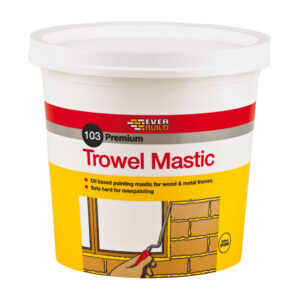When you’re installing metal and wood window frames and door frames you need to make sure they’re totally watertight on the outside. That’s the advantage of bitumen trowel mastic. It’s made of bitumen, oil and fibres. When trowel mastic is applied it provides a hard, waterproof surface but a spongy centre. This centre allows it some give in the face of thermal expansion.
Thermal expansion occurs when an object gets heated up and expands slightly. However, different materials expand at different rates, so thermal expansion can cause damage when a join is totally snug. Without this give you could be putting your windows at risk of cracking when it gets hot, or of damage occurring to your frames.
You will need:
- Trowel mastic
- Trowel or Putty Knife
The trowel mastic should be applied during the installation process. The area should first be cleaned of grease and grime and dried. Then mastic should be pushed into the joint using the trowel or knife, creating a solid piece with no gaps within. If the mastic doesn’t feel workable try to warm it up by leaving the bucket in sunlight for a few hours. You may need to really work the mastic upwards and downwards repeatedly to force it in the gap solidly. In order to achieve a smooth finish you can try working in layers, gradually building up.
The result should be a fillet that plugs the gap in the join. For ideal results, you should end up with roughly a surface face of 10-12mm. As for depth, it should be at least 6mm. After application trowel mastic can take from a week to a month to properly dry, depending on conditions. Then it can be painted over to match your frames or wall. Trowel mastic shouldn’t be used with plastic window frames. Using them with heat-absorbing windows may also cause issues.







